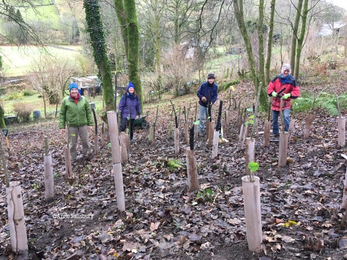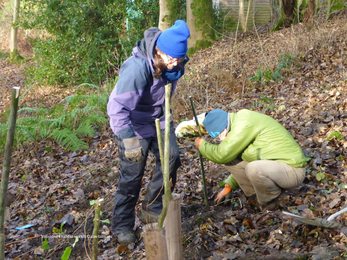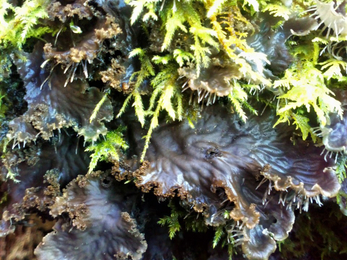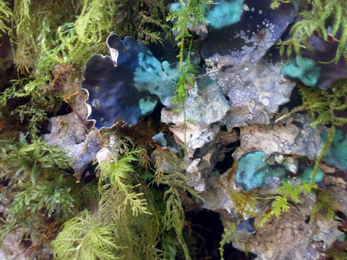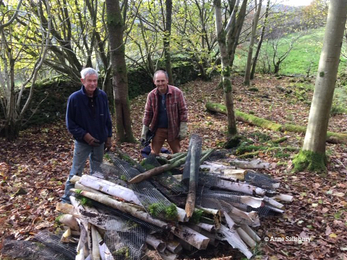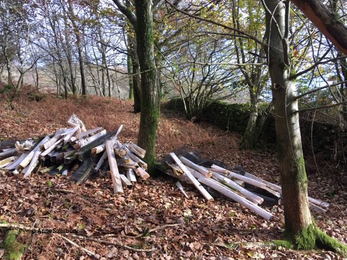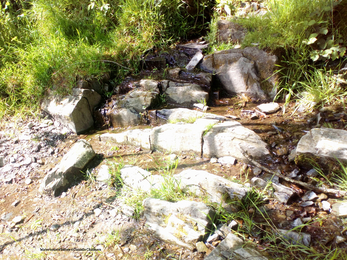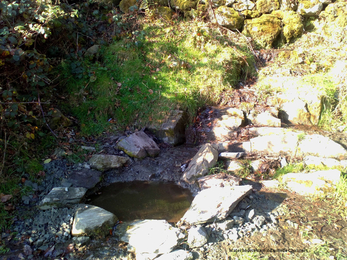We are using tree protection recycled from other planting projects around the county to avoid having to buy any plastic tree tubes. We are also using surplus sheep fleece from Cumbrian farms as weed suppressant around the base of the newly planted trees, to give them the best start. The fleece also slowly releases nutrients into the ground too. It really is starting to look like a tree nursery now.
Planting and pit-steads
© Jane Wilson
We had our first Conservation Day in Dorothy Farrer’s Spring Wood this month. We spent the day clearing an overgrown, forgotten footpath that creates a small circular route through the coppice coups. There were some lovely new finds while we were clearing the path too: two very lovely lichens growing along the wall side, one of which I am still awaiting an ID on as it’s a new one to me.
There were also some small trees and large branches that needed clearing from the pathways through the rest of the woods that had taken a battering from last month’s wind and rain. While we were doing this, we were admiring how the ferns are dying back for winter and now the greenery is off all the trees, we can see the amazing circular pit steads clearly in the woods. These reminders of our woodlands' industrial past are often hidden away, but at this time of year make themselves known. It’s a lovely reminder of how much we relied upon our woodlands in the past, and that all our woodlands have a hidden story to be told.
Another big task for us was to establish how much deer proofing we need to do around the coppiced area of the wood. As we now have someone coppicing, it’s important for us to keep the deer from coming in and eating the new growth. Luckily, there was not too much damage to the fencing, but there are quite a lot of wall gaps to put up on our next conservation day in Dorothy Farrer’s in January.
On the new land that we will be opening up as the footpath between Craggy Wood and Dorothy Farrer’s there is a lovely piece of woodland that we will go through; this is “Little Wood”. It is a fabulous bluebell wood in the spring and has an amazing restored pot ash kiln that links with the historical use of both the woodlands. Three of our volunteers made their way up to Little Wood to collect all the tree protection that had been left around the wood. They did a great job as there was a quite a lot and now we can take them down to the tree nursery to re-use.
Also on the new land there is a water source that needed re-directing into the neighbouring field. I have been working hard on establishing a route for it go, and a way to collect and contain this water as a water source. A little more work needs to be done on this next month, lining the culvert with reclaimed slate tiles to keep the edges more secure and the water flowing freely.
As you can see November has been a very busy month for work on the ground. This work will continue throughout the winter months, as there is less chance of disturbing any nesting wildlife at this time of year. The next Conservation Days and events can be found on the What’s on Page. If you would like to book on any, please email the office on events@cumbriawildlifetrust.org.uk and we will send you more details.
Until next month
Danni
Danielle Chalmers - Staveley Woodlands Officer

